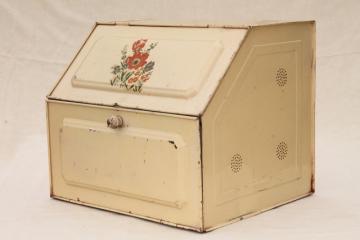No doubt many here still wear bed jackets, hats (with hat pins) and gloves when going to town, corsets (or "foundations") and sensible shoes. Those were for women, of course. Men would continue to wear tie clasps or tacks, cuff links, smoking jackets in the evening and the latest Palm Beach suits, at least in the summer. But does anyone still use a bread box?
When I was little, in the 1950s, bread boxes were apparently a standard, if not exactly essential, kitchen accessory. They were basically just tin boxes with a hinged lid. I don't think they were actually tinned but generally just painted and were of a utilitarian quality similar to the metal boxes that gift cookies sometimes come in. They were decorated but not really intended for display, as was nothing in the kitchen at the time. You would never have your company in the kitchen if you could avoid it. These days company tends to gravitate to the kitchen presumably because it is a more relaxed atmosphere, even though everyone has to stand up. I suspect that bread boxes pre-date sliced bread by no more than a couple of decades, if that. Anyway, we had one and I'm struggling to remember where it sat. It's other utility was as a measure of comparative size, as in "Is it bigger than a breadbox?"
Another less remembered piece of tin ware found in old-fashioned kitchens was what I might call a match dispenser or holder. If you had one, it would be hanging on the wall somewhere near the stove or perhaps the fireplace. But it meant that you either had a wood-burning range or a gas stove that lacked a pilot light. We had neither of those so we didn't have a match dispenser or matchbox holder but a couple of neighbors still used wood burning kitchen ranges and they did indeed have match dispensers.
I doubt if you can buy, new, either of those items, not even from the Vermont Country Store, although I think they have bed jackets for ladies. No corsets or smoking jackets, though.
When I was little, in the 1950s, bread boxes were apparently a standard, if not exactly essential, kitchen accessory. They were basically just tin boxes with a hinged lid. I don't think they were actually tinned but generally just painted and were of a utilitarian quality similar to the metal boxes that gift cookies sometimes come in. They were decorated but not really intended for display, as was nothing in the kitchen at the time. You would never have your company in the kitchen if you could avoid it. These days company tends to gravitate to the kitchen presumably because it is a more relaxed atmosphere, even though everyone has to stand up. I suspect that bread boxes pre-date sliced bread by no more than a couple of decades, if that. Anyway, we had one and I'm struggling to remember where it sat. It's other utility was as a measure of comparative size, as in "Is it bigger than a breadbox?"
Another less remembered piece of tin ware found in old-fashioned kitchens was what I might call a match dispenser or holder. If you had one, it would be hanging on the wall somewhere near the stove or perhaps the fireplace. But it meant that you either had a wood-burning range or a gas stove that lacked a pilot light. We had neither of those so we didn't have a match dispenser or matchbox holder but a couple of neighbors still used wood burning kitchen ranges and they did indeed have match dispensers.
I doubt if you can buy, new, either of those items, not even from the Vermont Country Store, although I think they have bed jackets for ladies. No corsets or smoking jackets, though.




